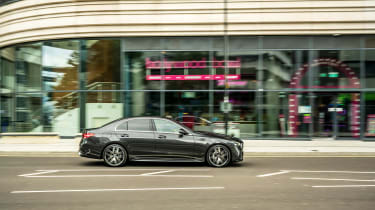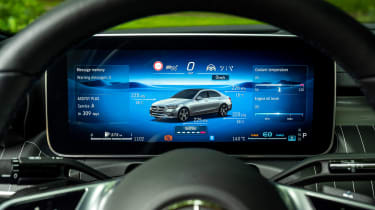Mercedes C-class review – engine, gearbox and technical highlights
All petrol and diesel fours come with either mild or plug-in hybridisation
After two generations of the C-class being topped with V8 engines, and V6s playing their role in the middle, it’s fair to say there were a few raised eyebrows when Mercedes confirmed the W206 would be four-cylinder only. While the demise of AMG’s V8 was no surprise due to stricter emissions regulations, it was the packaging that killed off the sixes as Merc’s latest generation swapped out a V6 layout for an in-line six.
In order to fit the new powertrain, Mercedes confirmed that it would have required an extra 50mm of length in the engine bay, space the engineers weren’t willing to compromise on for the sake of what would inherently have been a niche powertrain option.
To compensate, both of the new C-class’s four-cylinder engines are available in two outputs, with Merc’s EQ Boost mild-hybrid system applied to petrols and diesels. There’s also a plug-in C300e upping the size of the electric motor and battery pack. The MHEV’s EQ Boost motor is one we’ve seen before, being an integrated starter motor and generator which adds 20bhp and 147lb ft to the figure sheet.
> Mercedes-AMG C63 S (W205) review
Base-level C200 models are rated at 201bhp and 221lb ft of torque, with C300 models upping this to 254bhp and 295lb ft. Diesel engines are still on the menu too, with the C220d coming with 197bhp and 324lb ft and the top-spec C300d hitting with a very impressive 261bhp and 406lb ft. The plug-in hybrid model pairs the lesser 201bhp four-cylinder with a more potent 127bhp electric motor to create a 328bhp combined peak power and 406lb ft, making it the most powerful non-AMG variant.
The compromise in the C300e is weight. Most MHEV C-class models weigh around 1600 to 1700kg, but this shoots right up to a staggering 2005kg for the plug-in – the compromise for such an impressive all-electric range. The driver of this astonishing weight penalty is the comparatively huge 25.4kWh battery pack, some 4kWh bigger than the one in an original BMW i3, for context.
All-wheel-drive variants are still to come, as are the inevitable AMGs. All C-classes also utilise a nine-speed automatic transmission that’s sharp, responsive and brilliantly keyed in to the increasingly complicated powertrain – calibration really is top-notch.






